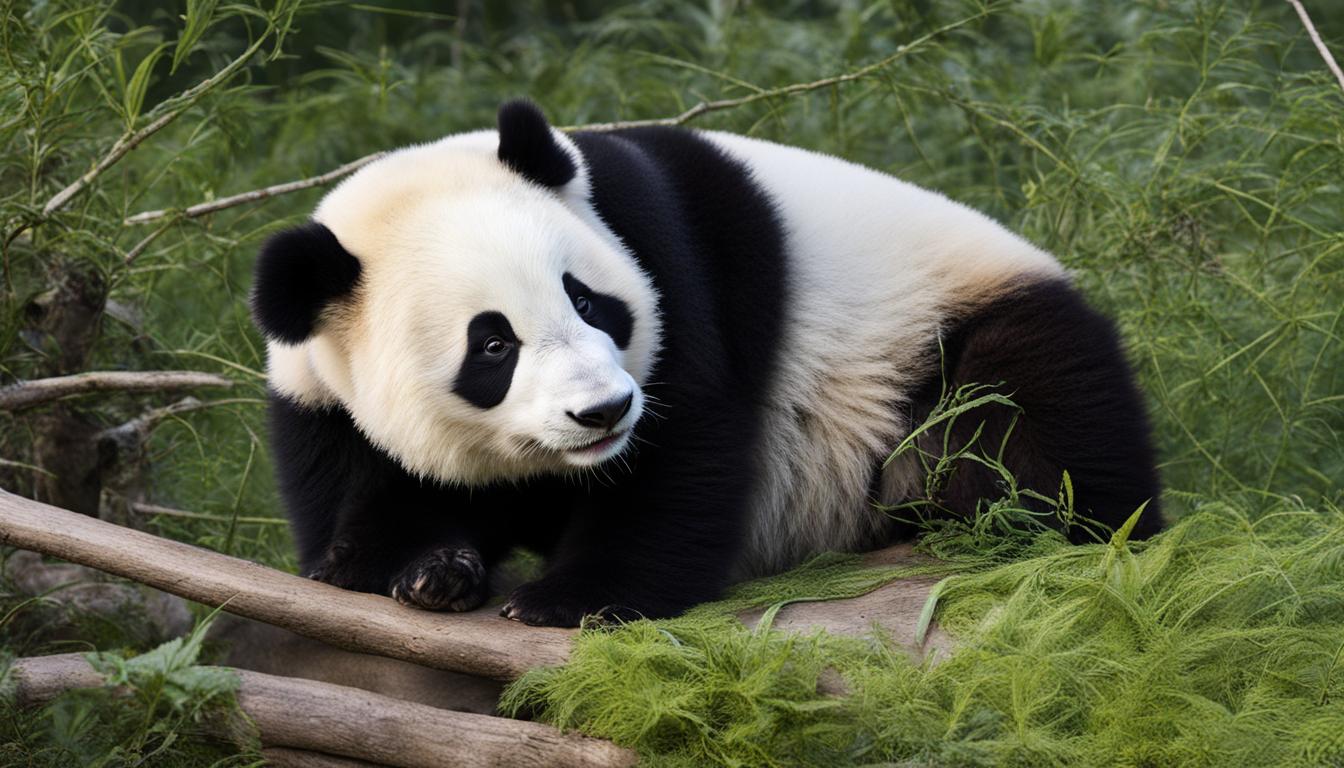When it comes to the anatomy and body structure of giant pandas, there are some fascinating characteristics that make them truly unique. From their stocky, barrel-shaped shape to their specialized bone structure, pandas are built for their bamboo-filled world.
Male pandas can weigh between 85-125 kg (187-276 lb), while females range from 70-100 kg (154-220 lb). Their body length stretches from 160-190 cm (5.3-6.2 ft), and their distinctive heads feature wide cheekbones and robust chewing muscles.
One of the most interesting aspects of a panda’s body structure is their skeletal system. Their legs are shorter than other bears, with forequarters heavier than hindquarters, allowing them to climb trees with ease. Their front feet have five digits plus an opposable “thumb” for grasping bamboo stems.
The fur of a giant panda is short and thick, providing insulation and protection against the cold. Males are generally larger than females, weighing about 18% more.
Understanding the anatomy and body structure of pandas is essential to appreciate their remarkable physical attributes and aid in their conservation efforts. By studying and protecting these magnificent creatures, we can ensure their survival and preserve their unique body structure for future generations to admire.
Skeletal Features of a Giant Panda
The skeletal features of a giant panda play a crucial role in supporting and protecting its body. The panda’s skeletal system provides structural integrity, enables movement, and serves as a reservoir for calcium. Understanding the bone structure of these magnificent creatures helps shed light on their unique adaptations.
The skull of a giant panda is large and houses the brain and eyes. It features wide, flaring cheekbones, robust chewing muscles, and a pronounced sagittal crest down the midline. The ribcage protects the heart and lungs, while the vertebrae safeguard the spinal cord. One distinctive skeletal feature of pandas is their enlarged wrist bone, known as the “thumb,” which allows them to firmly grasp bamboo stems with their forepaws.
| Skeletal Features | Description |
|---|---|
| Skull | Large with wide cheekbones and pronounced sagittal crest |
| Ribcage | Protects the heart and lungs |
| Vertebrae | Protects the spinal cord |
| “Thumb” | Enlarged wrist bone for grasping bamboo stems |
The teeth and jaw structure of the panda are uniquely adapted for their bamboo diet. Pandas have strong, rigid teeth that can crush tough bamboo, allowing them to efficiently extract nutrients from their primary food source. The skeletal system of a giant panda consists of different types of cells, such as osteoprogenitor cells, osteoblast cells, osteoclast cells, and osteocytes, which contribute to bone structure and maintenance.
By studying the skeletal features of giant pandas, scientists gain valuable insights into their evolutionary history, locomotion, and dietary adaptations. These remarkable skeletal adaptations enable pandas to thrive in their natural habitat and contribute to their distinctive appearance and behavior.
Muscular System of Giant Pandas
The muscular system of giant pandas plays a vital role in their movement, posture, and overall wellbeing. These fascinating creatures rely on their muscles for climbing trees, navigating their territory, and engaging in various activities to maintain their physical health. Let’s explore the key aspects of the muscular system that contribute to the remarkable abilities of giant pandas.
Powerful Skeletal Muscles
The skeletal muscles of giant pandas are essential for their locomotion and agility. These muscles, attached to the skeleton, allow pandas to move their limbs, grasp objects, and maintain balance. With their strong skeletal muscles, pandas exhibit incredible strength and dexterity, enabling them to climb trees and navigate challenging terrain effortlessly.
Specialized Jaw Muscles
The jaw muscles of giant pandas are particularly noteworthy due to their robustness. These strong muscles enable pandas to chew and consume large quantities of bamboo each day. The muscular strength in their jaws allows them to efficiently crush and process the tough bamboo fibers, providing them with the necessary nutrition for survival.
“The muscular system of giant pandas is truly remarkable. Their powerful skeletal and jaw muscles enable them to exhibit incredible strength, agility, and dietary adaptation.”
In addition to the skeletal and jaw muscles, giant pandas also possess smooth muscles, which are found in their digestive system, blood vessels, airways, and uterus in females. These smooth muscles facilitate the digestion of bamboo, regulate blood flow, and support various physiological functions.
| Muscle Type | Function |
|---|---|
| Skeletal Muscles | Enable movement, balance, and agility |
| Jaw Muscles | Facilitate chewing and digestion of bamboo |
| Smooth Muscles | Aid in digestion, blood flow regulation, and reproductive processes |
Overall, the muscular system of giant pandas showcases remarkable adaptations that allow them to thrive in their natural habitat. From their powerful skeletal muscles, enabling them to climb and move with ease, to their specialized jaw muscles, facilitating efficient bamboo consumption, every aspect of their muscular anatomy contributes to their unique abilities. Understanding the anatomy and function of the panda’s muscular system is crucial for the conservation and preservation of these magnificent creatures.
Respiratory and Circulatory Systems of Giant Pandas
Giant pandas have a unique respiratory system that enables them to breathe efficiently and adapt to their environment. Their respiratory system consists of the lungs, trachea, bronchi, and diaphragm. When a panda breathes in, air enters through the mouth or nose and travels down the trachea. From there, it branches out into smaller bronchi, eventually reaching the alveoli, where the exchange of oxygen and carbon dioxide takes place. This process allows the panda to take in oxygen and remove waste gases, ensuring the proper functioning of their body.
In addition to their respiratory system, pandas also have a well-developed circulatory system that transports oxygen and nutrients throughout their body. The circulatory system includes the heart, arteries, veins, and blood. The heart plays a crucial role in pumping oxygen-rich blood to the rest of the panda’s body, supplying nutrients and oxygen to their cells. The veins then carry deoxygenated blood back to the heart, where the process starts again. This continuous circulation ensures that the panda’s organs and tissues receive the necessary oxygen and nutrients to function optimally.
The respiratory and circulatory systems of pandas work together to support their overall body structure and function. These systems ensure that oxygen is efficiently delivered to the cells and waste gases are properly eliminated. By maintaining a healthy respiratory and circulatory system, pandas can thrive in their natural habitat and carry out essential activities such as foraging, climbing, and reproducing.
The Importance of Respiratory and Circulatory Systems for Pandas
The respiratory and circulatory systems are vital for the survival and well-being of giant pandas. These systems allow them to adapt to their bamboo-rich diet, which requires significant energy expenditure. The efficient exchange of gases in the respiratory system ensures that pandas have enough oxygen to support their active lifestyle. Meanwhile, the circulatory system delivers oxygen and nutrients to their muscles, enabling them to climb trees and engage in other physical activities.
Additionally, a properly functioning respiratory and circulatory system is crucial for pandas’ reproductive success. Adequate oxygenation and nutrients are essential for the development of healthy cubs. A well-oxygenated blood supply also supports the mother panda during pregnancy and lactation, allowing her to provide the necessary nutrients to her offspring.
In conclusion, the respiratory and circulatory systems of giant pandas play a key role in their overall body structure and function. These systems ensure the efficient exchange of gases, delivery of oxygen and nutrients, and support their active lifestyle and reproduction. Understanding the intricacies of these systems is crucial for the conservation and preservation of these magnificent creatures.
Conclusion
The anatomy and physical structure of giant pandas are truly fascinating. From their stocky body shape to their specialized skeletal and muscular systems, pandas are uniquely designed creatures. Their body structure, including their large head with wide cheekbones, robust chewing muscles, and distinctive sagittal crest, sets them apart.
With their shorter legs and forequarters that are more massive than their hindquarters, pandas have the ability to climb trees and move around their territory. Their front paws are equipped with an opposable “thumb” that allows them to grasp bamboo stems, which form a significant part of their diet.
Not only are pandas physically remarkable, but their respiratory and circulatory systems are also well-adapted for survival. Their respiratory system efficiently oxygenates their bodies and eliminates waste gases, while their circulatory system ensures the transport of oxygen-rich blood and nutrients throughout their body. These systems work together to support pandas’ unique lifestyle and enable them to thrive in their bamboo forest habitat.
Understanding the anatomy and physiology of giant pandas is vital for their conservation and protection. By studying and learning about these magnificent creatures, we can contribute to their survival in the wild. Let us continue to appreciate and preserve the remarkable physical features of giant pandas for future generations to admire.
How does the anatomy and body structure of a koala compare to that of a giant panda?
The anatomy and body structure of koalas differ significantly from that of giant pandas. Koalas have specialized digestive systems to process eucalyptus leaves, while giant pandas have evolved to consume bamboo efficiently. Additionally, koalas have strong limbs for climbing, while giant pandas have adapted to their environment with a unique thumb-like structure.
FAQ
What is the anatomy and body structure of a giant panda?
The anatomy and body structure of a giant panda is characterized by its stocky, barrel-shaped body shape, large head with wide, flaring cheekbones, robust chewing muscles, and a pronounced sagittal crest. Their legs are shorter than most bears, with forequarters more massive than hindquarters. They have a unique “thumb” for grasping bamboo, and their fur is short and thick.
What are the skeletal features of a giant panda?
The skeletal system of a giant panda supports and protects its body. The bones enable movement and provide calcium. The skull is large, the ribcage protects the heart and lungs, and vertebrae protect the spinal cord. Pandas have a special “thumb” bone for holding bamboo stems, and their teeth and jaw structure are designed for their bamboo diet.
What is the muscular system of a giant panda?
The muscular system of a giant panda enables movement, maintains posture, and circulates blood. Skeletal muscles are responsible for movement, smooth muscles are found in the digestive system, blood vessels, airways, and uterus, and cardiac muscles in the heart contract involuntarily. The muscles provide strength, balance, and the ability to climb and move around their territory.
How do the respiratory and circulatory systems of giant pandas work?
The respiratory system allows for breathing, with the lungs, trachea, bronchi, and diaphragm being the main organs. Oxygen is absorbed by red blood cells and delivered to other cells, while carbon dioxide is exhaled. The circulatory system, consisting of the heart, arteries, veins, and blood, carries oxygenated blood and nutrients throughout the body. Platelets in the blood help stop bleeding when the panda is injured.
What is the conclusion regarding panda anatomy and body structure?
The giant panda possesses a unique anatomy and body structure that allows it to thrive in its natural habitat. Understanding their physical features is crucial for conservation efforts and ensuring their survival in the wild.







